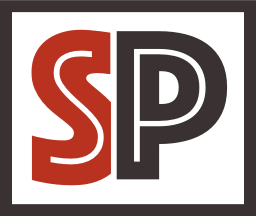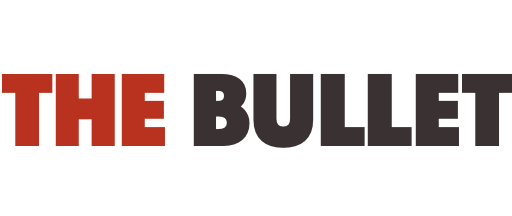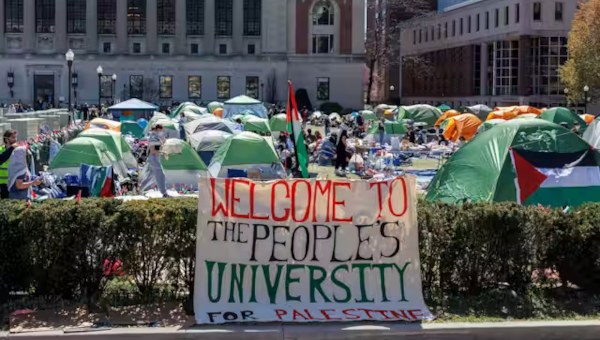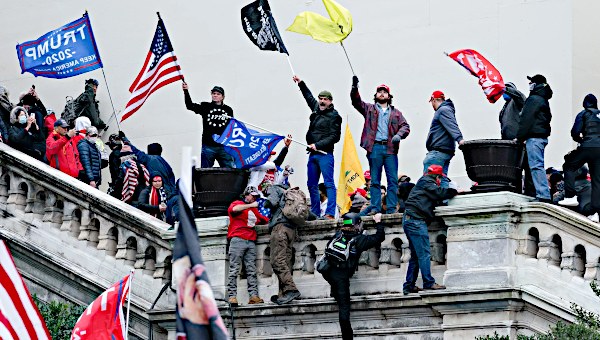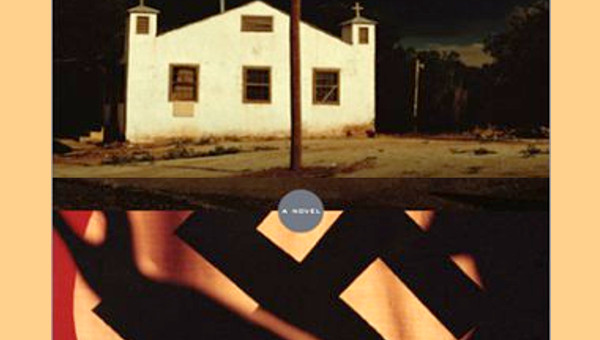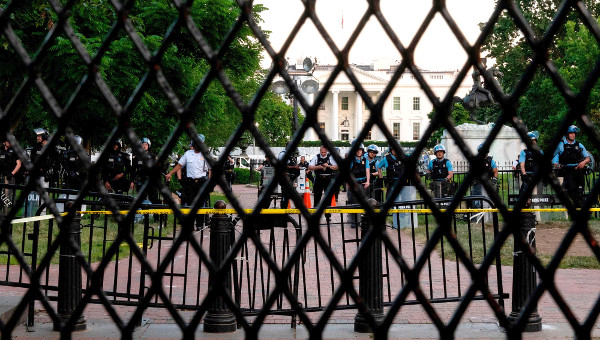Trump’s America: Echoes of a Fascist Past
“Historically, the most terrible things war, genocide, and slavery have resulted not from disobedience, but from obedience.” — Howard Zinn
The irony is unbearable. US President Donald Trump has saturated public life in lies, turned immigrants and Black citizens into targets of contempt, and made corruption and violence the new grammar of governance. He pledges loyalty to dictators, surrounds himself with sycophants and thugs, and wields state power as a weapon – abducting foreign students, persecuting immigrants, and declaring war on political dissent. Even in moments of tragedy, he traffics in cruelty, grotesquely blaming the left for Charlie Kirk’s death before the alleged suspect, Tyler Robinson, was even arrested. What should have been a moment of collective grief became a theater of vengeance, staged to inflame hatred and consolidate power.
This is not the language of democracy but the lexicon of authoritarian rule. Each of these acts signals how far the nation has fallen: the machinery of the state now turned inward against the vulnerable, dissent recast as treason, and violence sanctified as a governing principle. The United States is no longer inching toward fascism; it has descended into its abyss – where truth is sacrificed to spectacle, reason collapses into myth, and power feeds upon fear.
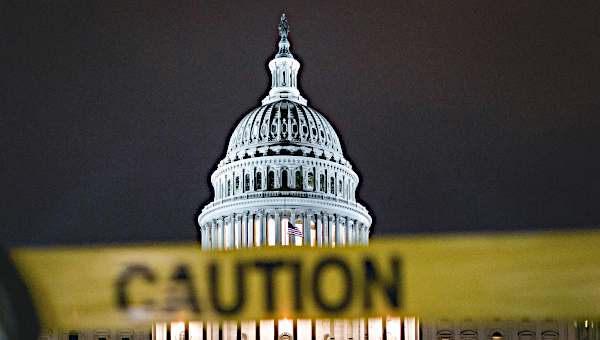
Trump Blames the Left
As Jeffrey St. Clair observed, “Leaders of the Right didn’t waste much time counseling their ranks to restrict themselves to ‘thoughts and prayers’ over the murder of Charlie Kirk. Even before the assassin had been identified or a motive uncovered, they blamed the ‘violent rhetoric’ of the Left for Kirk’s death.” This is not mourning, it is the oldest trick in the authoritarian playbook: accuse first, investigate never, weaponize tragedy to consolidate power. This strategy of weaponizing grief reached its clearest expression at Kirk’s funeral. At Charlie Kirk’s funeral, President Trump transformed what should have been a grave occasion into a political rally steeped in poisonous rhetoric.
In a speech steeped in resentment and vengeance, Trump thundered that the violence that took Kirk’s life “largely comes from the left,” offering no evidence and conveniently ignoring the accelerating surge of far-right extreme violence. His words were not idle. He framed progressives as enemies of the nation and signaled his willingness to wield state power against them, branding antifascist resistance as terrorism. Within days, he declared “Antifa” a “domestic Terrorist” organization” – a cynical distortion, since Antifa is not a structured entity but a decentralized leaderless movement of antifascist resistance. Soon after, Trump signed a presidential memorandum on “domestic terrorism” titled the National Security Presidential Memorandum designed to unleash the machinery of government against left-wing dissent, even naming the Democratic Party, George Soros, and Reid Hoffman as supposed funders of radical violence. C.J. Polychroniou rightly argues that “this memorandum, which is far more dangerous than the Antifa order, is a truly fascist blueprint that directs the federal government to go after ‘anti-fascist,’ ‘anti-capitalist’ movements in the US. It basically targets anyone who is opposing Trump and his MAGA ideology. As Rebecca Falcone warned in Axios, what is unfolding is nothing less than the institutionalization of politically motivated repression – a calculated campaign to delegitimize opposition and muzzle anyone daring to hold Trump to account. Yet Falcone stops short. What looms before us is far more ominous: the resurrection of fascist specters, refashioned for our time, threatening to darken the future with the familiar stench of authoritarianism reborn.
If Trump’s words voiced and legitimated the law of repression, Stephen Miller’s rhetoric gave it the blaring rhythm of menace. At Kirk’s eulogy, Miller delivered what Jonathan Chait in The Atlantic called “a jarring piece of rhetoric,” cloaking his speech in the grandeur of Western civilization while invoking a cosmic struggle between light and darkness, good and evil. Yet beneath this language of moral purity lurked the dogma of white nationalism: those deemed evil and disposable were immigrants, people of color, and dissenters; those deemed worthy were white Christian nationalists. In exalting vengeance over forgiveness – even ignoring the widow’s call for compassion – Miller and Trump sanctified cruelty as a civic virtue. More ominously still, they fused mourning with menace, presenting dissenting speech as violence and repressive power as justice, openly declaring that the state itself would become the weapon to crush opposition.
In this poisonous narrative, the real “enemies within” are not the racists, insurrectionists, corrupt corporations, and right-wing extremists who stormed the Capitol, but rather the critics of authoritarian power as well as groups designated as “other.” Against them, Trump and his allies wage war on the First Amendment, turning freedom of speech from a cornerstone of democracy into its target. In their framing, freedom of speech is recast not as a bulwark of democracy but as its enemy. The consequences of such distortions extend beyond rhetoric. This warning is even more urgent today, for Trump’s willful ignorance unleashes predatory passions that nourish a culture of authoritarian violence.
Dissenting Voices
From comedians and journalists to students, educators, and independent groups, every dissenting voice is branded a conspirator in imagined crimes – their real offense nothing more than speaking against cruelty when silence was demanded. Or committing the crime of not being loyal enough to Donald Trump. As Hannah Arendt once warned, under totalitarianism thinking itself becomes dangerous. Authoritarianism in its many forms arises in part from the failure to think, a prescient warning in the age of manufactured ignorance. The normalization of ignorance, thoughtlessness, and moral blindness in the age of Trump is foundational to creating fascist subjects who cannot tell right from wrong, truth from lies, or justice from evil.
This warning is even more urgent today, for there is a horrifying ignorance in Trump that unleashes predatory passions, stretching from his embrace of war criminals and historical amnesia to the fatal strikes he ordered on three alleged drug-smuggling vessels. For Trump, the legality of such acts is irrelevant. Violence coupled with criminalizing dissent is central to the logic of annihilation at the core of fascist politics.
This is fascism’s signature maneuver. Adolph Hitler did it in 1933 after the Reichstag fire, blaming communists and invoking emergency powers to suspend civil liberties. In 1938, Joseph Goebbels used the assassination in Paris of a Nazi official by 17-year-old Herschel Grynszpan, a Jew, to launch Kristallnacht, which “became a turning point in German policy, setting into motion the Nazis’ systematic extermination of Jews, the Romani people, Communists, Christians, homosexuals, the mentally ill.” Benito Mussolini followed a similar script in 1925 after the assassination of Giacomo Matteotti, turning a moment of crisis into a justification for outlawing opposition and silencing presses. More recently, Orbán has perfected the tactic in Hungary, scapegoating “Soros-funded leftists” to dismantle universities, criminalize protest, and eviscerate the press.
Trump is no exception. He exploits Kirk’s death not to grieve but to consolidate power. His message is blunt: dissent is violence, criticism is terrorism, disloyalty is a crime, and free speech itself is a threat to Trump’s ideological panopticon. The vicious amplification of this line of toxic thinking is evident in the rhetoric of Trump’s consigliere Laura Loomer, who following Kirk’s assassination, demanded the state “shut down, defund, and prosecute every single Leftist organization.” The rhetoric reached hysterical heights with Christopher Rufo, a leading far-right critic of higher education, who declared “The last time the radical Left orchestrated a wave of violence and terror, J Edgar Hoover shut it all down within a few years. It is time, within the confines of the law, to infiltrate, disrupt, arrest, and incarcerate all of those who are responsible for this chaos.” The rhetoric is chilling not only for its cruelty but for its naked embrace of repression and the threat of violence as state policy.
Trump’s Chilling Message
The consequences of Trump’s assault on dissent flare like an over-sized blazing neon sign in Times Square, impossible to ignore. Under his lawless reign, even satire is recast as “un-American,” branded a ‘hate crime,’ as though laughter itself had become treason. Academic institutions that keep alive the memory of history and the struggles for freedom are stalked with mob-like threats, extortion parading as patriotism, intimidation masquerading as loyalty. Canadian citizens are being threatened with visa revocation simply for making what Marco Rubio, Stephen Miller, Pam Bondi, and others defined as critical comments about Kirk’s death. This sends a chilling message: Trump’s authoritarian reach now crosses borders, extending its silencing power beyond US soil.
In this twisted logic, even a measured critique of Kirk is recast as a “celebration of his death” – a grotesque distortion divorced from reality. His passing should indeed be mourned, but mourning must not be conflated with silence about his far-right ideology. To condemn those beliefs is not cruelty; it is moral clarity. What emerges is a pattern both unmistakable and chilling: intimidation at the top reinforced by institutional complicity. Universities and workplaces mask this capitulation as neutrality, but it is in truth a collapse of ethical responsibility – a dark echo of the accommodations that enabled fascism in another era. The price of speaking out has become brutally clear. As The New York Times reports, more than 145 individuals have faced workplace reprisals – including firings – for criticizing Kirk’s ideology, even when they simultaneously condemned the shooting as horrific.
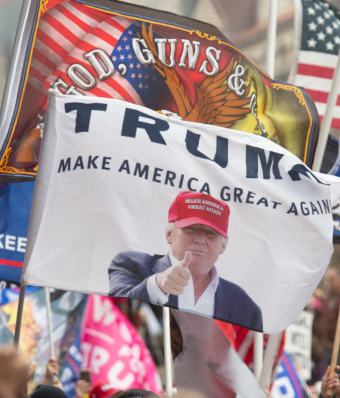
These acts of silencing are never isolated. They are instruments of power that legitimate broader forms of state violence. Censorship, propaganda, and the glorification of cruelty converge to normalize repression as both necessary and inevitable. Corporations and universities bow in fear and greed, sacrificing every shred of public responsibility to feed an unending hunger for power and capital. Nowhere is this surrender more shameful than in higher education, where universities crush dissent and betray their own students by handing over the names of those protesting genocide to the Trump administration – tragically repeating the cowardice of fascist-era campuses. Even worse, Ken Klippenstein reports that “the Trump administration is preparing to designate transgender people as ‘violent extremists’ in the wake of Charlie Kirk’s murder and are considering compiling a watchlist of Trans people.
It is a chilling echo of fascist-era complicities, a moral collapse disguised as institutional neutrality. The echo is haunting and has given rise to a new McCarthyism of campus informants, a reprise of the shameful complicities of fascist-era universities. As journalist David French argued on MSNBC’s All In with Chris Hayes show, the current attacks on free speech and dissidents critical of Trump are worse than McCarthyism, because it is “larger and broader in scope. It is more aggressive. It stretches across all aspects of American society.” This is not merely an institutional failure but also a moral collapse, a repudiation of knowledge, conscience, and the very democratic commitments that should define the purpose of the academy. What we are witnessing is McCarthyism reborn with a vengeance – surveillance, informants, blacklists. Higher education has long unsettled the right, especially since the democratizing struggles of the sixties. Today that fear has hardened into something darker: not merely efforts to weaken its critical role, but the imposition of pedagogical tyranny that turns universities into laboratories of indoctrination.
It gets worse. Trump, Rubio, Miller, Bondi, and their cohort of democracy’s enemies now threaten to strip dissenting Americans of their passports, revoke citizenship, and criminalize free speech. They howl in outrage at being compared to fascists, even as their actions mirror the same grim playbook: militarizing society, crushing dissent, concentrating power in the hands of a cult leader, and reanimating the legacy of white supremacy and racial cleansing.
Trump hails Netanyahu, a war criminal, as a war hero. With grotesque irony, he denounces the left as the true perpetrators of violence. At home, his vindictiveness is just as corrosive: boasting of pressuring ABC to fire Jimmy Kimmel – now back on the air. This petty act of vengeance amounts to his own assault on the First Amendment and is a chilling reminder of how fragile free speech becomes under authoritarian whim. Yet no alarm is sounded when Fox News host Brian Kilmeade casually suggests exterminating the homeless through “involuntary lethal injections.” Nor does outrage rise in the Trump administration, or much of the mainstream press, over the United States’ complicity in Israel’s genocidal war on Gaza, where, as the Quds News Network reports, “At least 19,424 children have been killed in Israeli attacks over 700 days of genocide in Gaza, the equivalent of one child every 52 minutes. Among the victims are 1,000 infants under the age of one.” Silence here is not neutrality; it is complicity in barbarism.
When the conduct of comedians is criminalized, it is not simply a matter of taste, decorum, or even misplaced moral outrage; it is a direct assault on the principle of free speech. Comedy has always served as a space where hypocrisy is unmasked, abuses of power are ridiculed, and the absurdities of authoritarian politics are laid bare. In fact, when Vladimir Putin first came to power in 2000, one of the early targets of his cultural crackdown was the satirical television show “Kukly” (Куклы, meaning dolls), a puppet show produced by the independent channel NTV. Apparently being called the little Tsar puppet was too much for him to tolerate. This ruthless act of censorship was widely seen as a watershed moment in Putin’s consolidation of power. The real issue is that policing or punishing comedians signals the state’s desire to control even the spaces of laughter and satire.
Canary in the Coal Mine
This criminalization is more than censorship; it is a canary in the coal mine for gauging the advance of fascism. When jokes are reclassified as crimes, the warning could not be clearer: what begins with comedians will not end with them. It marks the testing of boundaries, the normalization of repression, and the silencing of one of the oldest and most effective forms of dissent. The move reveals the fragility of regimes that cannot tolerate critique, no matter how playful or irreverent, and it signifies a broader project to narrow public space until only official voices remain.
In this sense, the attack on comedy should not be dismissed as a trivial or secondary issue. It is a symbolic and practical escalation of authoritarian politics, one that exposes the contempt fascist movements hold for humor, irony, and dissenting speech. If laughter is made a crime, then resistance itself is already under indictment. Repressing dissent has a long history in the US extending from the Red Scare of the 1920s to the domestic repression that followed Bush’s war on terrorism. Today’s attacks on dissent are more widespread, damaging, and unchecked than much of what we have seen in the past. To borrow a phrase from Terry Eagleton, Trump and his MAGA stooges are drunk “on fantasies of omnipotence” and revel in acts of violence, destruction, and the exercise of boundless state power.
The parallels with fascist history could not be more ominous. After Kristallnacht, the Nazis suspended civil liberties and imprisoned communists; today, Trump declares dissent worthy of censorship and, if Pam Bondi is to be taken at face value, will be labeled as hate speech and subject to state repression. Benito Mussolini used Giacomo Matteotti’s assassination to further consolidate his own power; today, Trump uses Kirk’s death to silence students, educators, and journalists. Orbán dismantled Hungary’s free press and universities by conjuring enemies; today, Trump and Miller invoke “the radical left” as an existential threat.
Violence in America’s militarized streets now fuses with what John Ganz calls a “sanctimonious hue and cry … over the martyred dead, hysteria is whipped up about terrorism and public disorder [and] the power of the state is brought to bear against public figures who oppose and criticize the regime.” Fear has become the regime’s preferred weapon, wielded alongside a politics of erasure, historical amnesia, and ruthless denial.
Jeffrey St. Clair noted with grim precision that Kirk’s killing is “awful, disgusting and about as American as it gets,” but the hypocrisy lies in Trump’s silence after earlier acts of MAGA violence: “When two Democratic legislators and their spouses were assassinated by a Trump supporter in Minnesota a few weeks ago, Trump said nothing. Nada. Zilch.” Violence committed by the Right elicits no outrage, but a single death weaponized against the Left becomes the justification for a war on dissent. As St. Clair recounts, the ledger of right-wing violence between 2018 and 2025 reads like a requiem: the assault on CDC headquarters, the murder of Officer David Rose, the plot to seize Governor Gretchen Whitmer, the massacre of 23 souls in an El Paso Walmart, and the slaughter of 11 worshippers at Pittsburgh’s Tree of Life synagogue. Every act carried the rhythm of cruelty; every atrocity struck like a warning written in fire and blood.
In spite of the nefarious claims by Trump, Miller, Bondi, and other officials that the left bears responsibility for Charlie Kirk’s death, the facts tell a different story. NBC News reports that “the federal investigation into the assassination of conservative activist Charlie Kirk has yet to find a link between the alleged shooter, 22-year-old Tyler Robinson, and left-wing groups on which President Donald Trump and his administration have pledged to crack down.” The Trump regime refuses to acknowledge this, erasing evidence and fabricating a narrative designed to demonize its critics. This distortion follows a familiar historical pattern, yet what the Trump administration refuses to admit and desperately hide is that, according to the Anti-Defamation League, “since 2002, right-wing ideologies have fueled more than 70% of all extremist attacks and domestic terrorism plots in the United States.”
It should be noted, once again, that Kirk’s assassination, an utterly deplorable and indefensible act, was also seized upon to silence critics across the political spectrum, from journalists to professors, who expressed sorrow over his death while making clear they rejected his ideology. To mourn a life lost is not to endorse the ideas he espoused, and conflating criticism of those ideas with a cruel festive endorsement of his death is a dangerous distortion. As Saida Grundy brilliantly and powerfully observes in an essay in The Guardian, Kirk’s ideology was hardly something to be memorialized in a democracy. He “ruled over an online fiefdom peddling his signature brand of rage-baiting racist, xenophobic, Islamophobic and misogynistic commentary.” She adds that his appeal came not from reasoned persuasion, but from the “popularization of cruelty, humiliation and dehumanization of political opponents, especially college students,” which he orchestrated into a political style that attracted millions. He once dismissed empathy itself as “a made-up, new age term that does a lot of damage,” a sentiment that encapsulates his contempt for compassion and solidarity.
Grundy further notes that the state-sanctioned memorials for Kirk are designed to fuse his far-right worldview with the interests of the federal government, elevating white nationalist, homophobic, and misogynistic convictions as though they were national priorities. These memorials, she argues, echo the logic of Confederate monuments: they are not neutral commemorations but instruments of power, constructed to shield their subjects from scrutiny and to sanctify an ideology of exclusion. In this sense, Trump’s use of Kirk’s death is not only a tribute but also a strategy, a way to build Kirk’s extremism into a national narrative that legitimizes repression and white supremacy.
Celebrating Kirk’s hard-right extremism thus becomes a political weapon. The Trump administration has used his memorialization both to exalt Kirk’s views and to intimidate or harass those who dare to challenge them. This is more than denial or misrepresentation; it is calculated deceit. By inverting reality, by blaming dissenters for violence overwhelmingly stoked by their own ideological allies, the administration wages war on truth itself. Lies are weaponized to justify the silencing of critics and the tightening of state repression. It is the oldest tool of authoritarianism, a well-worn script from the fascist playbook in which regimes invent internal enemies to mask their own violence and consolidate their power.
Machinery of Fascism
This is the machinery of fascism: scapegoating, historical amnesia, and the fabrication of a “threat within” to mobilize fear and erase accountability. To remain silent in the face of such lies is to allow history’s darkest patterns to repeat. The ominous rattling of boxcars is no longer mere metaphor; it is rehearsal. The same trains that once ferried enemies of the state, Jews, communists, Roma, and others–to concentration camps echo in today’s discourse of surveillance, detention, and deportation. These echoes abroad make the danger at home impossible to ignore. The first targets are always the vulnerable, immigrants, refugees, students, and the homeless. But the machinery of repression, once primed, sweeps wider. What begins at the margins always moves to the center. As history shows, repression rarely halts at its first targets.
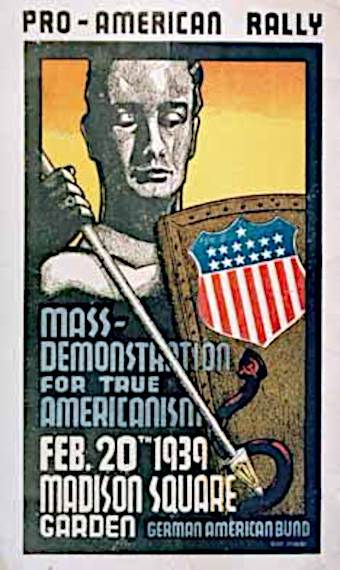
First the masked thugs of state-sponsored terror descended on immigrants, then on student protesters; they occupied neighborhoods, turned cities into militarized staging grounds, and normalized violence as the language of lawless rule. Now the machinery of repression is tightening its grip, moving ever closer to ordinary citizens. A shadow from an authoritarian past has fallen across the republic, and unless it is confronted, the future will echo the grim theaters of repression already unfolding in Hungary, India, and Argentina.
In all these countries including the United States, leaders of the new fascism speak with bile in their mouths and blood on their hands. They share a language that Toni Morrison calls “a dead language.” It is an “oppressive language, [which] does more than represent violence; it is violence.” Trump and his minions traffic in a repressive language infused with power, censored and censoring. Ruthless in its policing duties, it has no desire or purpose other than maintaining the free range of its own narcotic narcissism, its own exclusivity and dominance. It offers mass spectacles in place of thought, moral somnambulism, and a psychotic infatuation for those who seek refuge in unchecked power. It forges a community built on greed, corruption, and hate, steeped in a scandal of hollow fulfillment.
All of these threads converge in the present. In this historical moment, saturated with revenge, systemic racism, and the scaffolding of a police state, language itself is weaponized, turned into an instrument of manufactured ignorance. The Trump administration transforms grief into a rallying cry for repression. The radical imagination is smothered beneath conspiracy theories and civic amnesia. A hollow politics of cruelty now finds its counterpart in the ruthless machinery of state terrorism. At home, Trump and his enablers cast themselves as victims even as they spread violence, misery, and moral rot across the nation and beyond.
The stakes could not be clearer: silence is complicity. To speak, to talk back, and to engage in mass action is now the most urgent precondition for building powerful modes of collective resistance. Around the world, people are already showing what this looks like. In Italy, mass strikes have erupted against the government’s support for Israel’s genocidal war, a reminder that collective defiance can interrupt the machinery of repression and expose the moral bankruptcy of those in power. The lights are going out fast, but they are not yet extinguished. Justice, equality, and freedom can still be made the foundation of a radical democracy – but only if we act. Resistance is no longer optional; it is the urgent political and moral task of our time. •
This is an updated version of an article published on the CounterPunch website.
